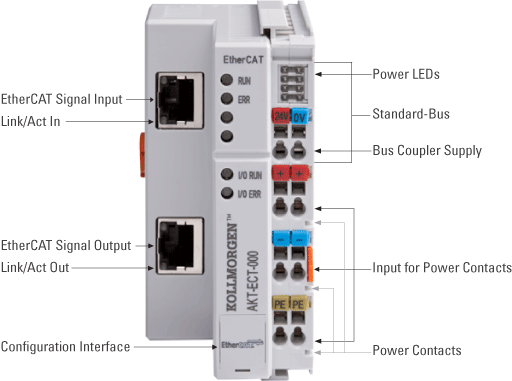General Specification
The ETHERCAT Coupler connects EtherCAT![]() EtherCAT is an open, high-performance Ethernet-based fieldbus system. The development goal of EtherCAT was to apply Ethernet to automation applications which require short data update times (also called cycle times) with low communication jitter (for synchronization purposes) and low hardware costs, the real-time Ethernet
EtherCAT is an open, high-performance Ethernet-based fieldbus system. The development goal of EtherCAT was to apply Ethernet to automation applications which require short data update times (also called cycle times) with low communication jitter (for synchronization purposes) and low hardware costs, the real-time Ethernet![]() Ethernet is a large, diverse family of frame-based computer networking technologies that operate at many speeds for local area networks (LANs) system, with the
modular, extendable electronic terminal blocks. A unit consists of a Bus
Coupler, a set of terminals, and
one end terminal.
Ethernet is a large, diverse family of frame-based computer networking technologies that operate at many speeds for local area networks (LANs) system, with the
modular, extendable electronic terminal blocks. A unit consists of a Bus
Coupler, a set of terminals, and
one end terminal.
The Bus Coupler recognises the connected Bus Terminals and automatically allocates them into the EtherCAT process image. The Bus Coupler is connected to the network via the upper Ethernet interface. The lower RJ 45 socket may be used to connect further EtherCAT devices in the same strand.
In the EtherCAT network, the ETHERCAT Coupler can be installed anywhere in the Ethernet signal transfer section (100BASE-TX) - except directly at the switch.
EtherCAT (Ethernet Control Automation Technology) is the Ethernet solution for industrial automation, characterized by outstanding performance and particularly simple handling. EtherCAT enables the Ethernet star topology to be replaced with a simple line structure. Optionally, EtherCAT may also be wired in the “classic” way using switches, in order to integrate further Ethernet devices. The master requires no special plug-in card and can be implemented on any existing Ethernet controller using a very simple interface. EtherCAT is therefore also well suited to small and medium control applications, where it will also open up new areas of application for distributed I/Os.
For EtherCAT a separate I/O system in protection class IP 20 is available in the form of EtherCAT Terminals. In contrast to Bus Terminals, where the fieldbus signal is implemented within the Bus Coupler on the internal, fieldbus-independent terminal bus, the EtherCAT protocol remains fully intact down to the individual terminal.
The ETHERCAT Coupler supports the operation of all Bus Terminals. As far as the user is concerned, handling of the analog inputs/outputs is not different to other series. The information is available in the process image of the controller for processing in the form of a byte array.
The analog and multifunctional
Bus Terminals can
be adapted to each specific
application. Depending
on the type, the analog Bus
Terminals’ registers contain
temperature ranges, gain values
and linearisation characteristics.
The Bus Terminals store settings
permanently and in a fail-safe
manner.
Optionally, the Bus Terminals
can also be controlled by the
control system. Via function
blocks (FBs), the programmable
logic controller (PLC![]() "Programmable Logic Controller"
A Programmable Logic Controller, PLC, or Programmable Controller is a digital computer used for automation of industrial processes, such as control of machinery on factory assembly lines.
Used to synchronize the flow of inputs from (physical) sensors and events with the flow of outputs to actuators and events) handles
configuration of the complete
periphery during the start up
phase. If required, the controller
can upload the decentralized
created configuration data in
order to centrally manage and
store this data. Therefore, new
adjustments are not necessary
in the event of replacement of
a Bus Terminal. The controller
automatically sets the required
setting on power up.
"Programmable Logic Controller"
A Programmable Logic Controller, PLC, or Programmable Controller is a digital computer used for automation of industrial processes, such as control of machinery on factory assembly lines.
Used to synchronize the flow of inputs from (physical) sensors and events with the flow of outputs to actuators and events) handles
configuration of the complete
periphery during the start up
phase. If required, the controller
can upload the decentralized
created configuration data in
order to centrally manage and
store this data. Therefore, new
adjustments are not necessary
in the event of replacement of
a Bus Terminal. The controller
automatically sets the required
setting on power up.
Electrical and Mechanical Specification

|
System Data
|
AKT-ECT-000-000
|
|---|---|
|
Number of I/O stations
|
65,535
|
|
Number of I/O points
|
depending on controller
|
|
Data transfer medium
|
Ethernet/EtherCAT CAT5 cable
|
|
Max. cable length
|
100 m (100BASE-TX)
|
|
Data transfer rates
|
100 Mbaud
|
|
Data transfer time
|
0.01 ms in the case of 10 modules for 32 bit inputs and outputs each (without Standard Bus run-time
|
|
Electrical and Mechanical Specification
|
AKT-ECT-000-000
|
|---|---|
|
Number of Bus Terminals
|
64 (255 with Standard Bus extension)
|
|
Max. number of bytes fi eldbus
|
1,024 byte input and 1,024 byte output
|
|
Configuration possibility
|
EtherCAT (ADS)
|
|
Bus interface
|
2 x RJ 45
|
|
Power supply
|
24 V DC (-15 %/+20 %)
|
|
Input current
|
70 mA + (total Standard Bus current) /4, 500 mA max.
|
|
Starting current
|
approx. 2.5 x continous current
|
|
Recommended fuse
|
≤ 10 A
|
|
Supply current Standard Bus
|
1,750 mA
|
|
Power contacts
|
24 V DC max./10 A max.
|
|
Electrical isolation
|
500 Vrms
|
|
Distance between stations
|
100 m (100BASE-TX)
|
|
Weight
|
approx. 150 g
|
|
Operating/storage temperature
|
0…+55 °C/-25…+85 °C
|
|
Relative humidity
|
95 %, no condensation
|
|
Vibration/shock resistance
|
conforms to EN 60068-2-6/EN 60068-2-27/29
|
|
EMC immunity/emission
|
conforms to EN 61000-6-2/EN 61000-6-4
|
|
Protect. class/installation pos.
|
IP 20/variable
|







